
Amaryllis is the only genus in the subtribe Amaryllidinae. It is a small genus of flowering bulbs, with two species. The better known of the two, Amaryllis belladonna, is a native of the Western Cape region of South Africa, particularly the rocky southwest area between the Olifants River Valley and Knysna.

Narcissus is a genus of predominantly spring flowering perennial plants of the amaryllis family, Amaryllidaceae. Various common names including daffodil, narcissus and jonquil, are used to describe all or some members of the genus. Narcissus has conspicuous flowers with six petal-like tepals surmounted by a cup- or trumpet-shaped corona. The flowers are generally white and yellow, with either uniform or contrasting coloured tepals and corona.
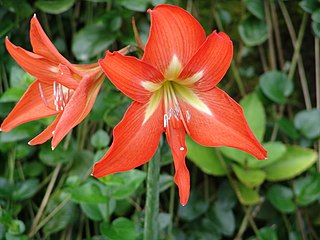
Hippeastrum is a genus of about 90 species, and over 600 hybrids and cultivars, of perennial, herbaceous and bulbous plants, native to tropical and subtropical regions of the Americas, from Mexico south to Argentina and on some islands in the Caribbean. The majority have large, fleshy bulbs—usually about the size of a softball—and tall, broad, strap-like leaves that are (generally) evergreen, and large red or purple flowers. Numerous colors and cultivars have been created over the past hundred years.

Leucojum is a small genus of bulbous plants native to Eurasia belonging to the amaryllis family, subfamily Amaryllidoideae. As currently circumscribed, the genus includes only two known species, most former species having been moved into the genus Acis. Both genera are known as snowflakes.
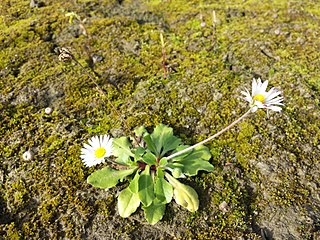
Bellis perennis, the daisy, is a European species of the family Asteraceae, often considered the archetypal species of the name daisy. To distinguish this species from other plants known as daisies, it is sometimes qualified or known as common daisy, lawn daisy or English daisy.

Nerine is a genus of flowering plants belonging to the family Amaryllidaceae, subfamily Amaryllidoideae. They are bulbous perennials, some evergreen, associated with rocky and arid habitats. They bear spherical umbels of lily-like flowers in shades from white through pink to crimson. In the case of deciduous species, the flowers may appear on naked stems before the leaves develop. Native to South Africa, there are about 20–30 species in the genus. Though described as lilies, they are not significantly related to the true lilies (Liliaceae), but more closely resemble their relatives, Amaryllis and Lycoris. The genus was established by the Revd. William Herbert in 1820.
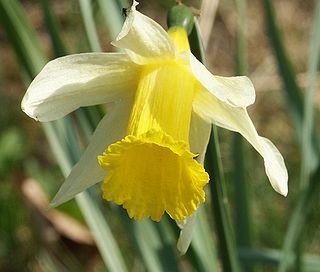
Narcissus pseudonarcissus, commonly named the wild daffodil or Lent lily, is a perennial flowering plant.
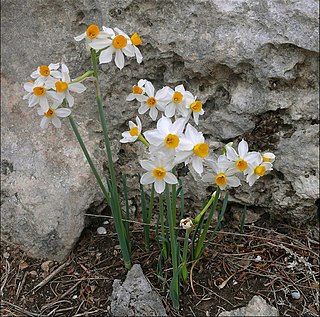
Narcissus tazetta is a perennial ornamental plant that grows from a bulb. Cultivars of N. tazetta include 'Caniculatus', 'Grand Soleil d'Or' and 'Ziva', which are popularly used for forcing indoors, as is the form of N. tazetta known as Chinese Sacred Lily.

Puschkinia is a genus of four known species of bulbous perennials in the family Asparagaceae, subfamily Scilloideae. It is native to the Caucasus and the Middle East. Puschkinia scilloides is grown as an ornamental bulbous plant.

Scadoxus is a genus of African and Arabian plants in the Amaryllis family, subfamily Amaryllidoideae. The English names blood lily or blood flower are used for some of the species. The genus has close affinities with Haemanthus. Species of Scadoxus are grown as ornamental plants for their brilliantly coloured flowers, either in containers or in the ground in frost-free climates. Although some species have been used in traditional medicine, they contain poisonous alkaloids.

Gladiolus italicus is a species of gladiolus known by the common names Italian gladiolus, field gladiolus, and common sword-lily. It is native to much of Eurasia and North Africa, but it is well known on other continents where it is a common weed, particularly of cultivated fields and waste places. This perennial flower grows an erect stem approaching a meter in maximum height with a few long leaves around its base. Toward the top half of the generally unbranching stem is a spike inflorescence on which flowers appear at intervals. Each plant has up to 15 or 16 flowers. The flower is bright pink to magenta and several centimeters long with its stamens and style protruding from the throat. The fruit is a capsule about a centimeter long containing many seeds.

Scadoxus cyrtanthiflorus is a herbaceous plant endemic to the Rwenzori Mountains of east tropical Africa. Unusually for the genus Scadoxus its tubular blooms are pendant. It is sometimes grown as an ornamental plant in heated greenhouses.

Tulips are spring-blooming perennial herbaceous bulbiferous geophytes in the Tulipa genus. Their flowers are usually large, showy, and brightly coloured, generally red, orange, pink, yellow, or white. They often have a different coloured blotch at the base of the tepals, internally. Because of a degree of variability within the populations and a long history of cultivation, classification has been complex and controversial. The tulip is a member of the lily family, Liliaceae, along with 14 other genera, where it is most closely related to Amana, Erythronium, and Gagea in the tribe Lilieae.
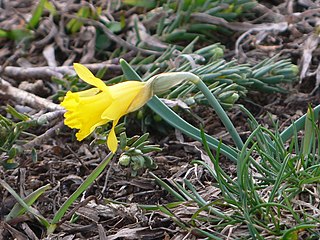
Narcissus asturiensis, the pygmy daffodil, is a perennial bulbous plant native to the mountains of North Portugal and Spain, where it grows at altitudes up to 2000 m (6000 ft). As of March 2022, Kew sources consider the correct name to be Narcissus cuneiflorus.

Lilium wallichianum is an Asian species of bulbous plants in the lily family native to the Indian Subcontinent and to Myanmar. It is native to India, as well as Nepal, Bhutan, and Myanmar.

Lilium concolor is a species of flowering plant in the lily family which occurs naturally in China, Japan, Korea and Russia. Its relationship with other species is not clear, although it has some similarities to Lilium pumilum.

Lobivia cinnabarina is a species of cactus first described in 1885.

Galanthus elwesii, Elwes's snowdrop or greater snowdrop, is a species of flowering plant in the family Amaryllidaceae, native to the Balkans and Asia Minor, where it is found in the countries of Bulgaria, Greece, Serbia, Moldova, Ukraine and Turkey.

Lobivia pentlandii, is a species of Lobivia found in Bolivia and Peru.

Dianthus albens is a species of flowering plant in the family Caryophyllaceae.























